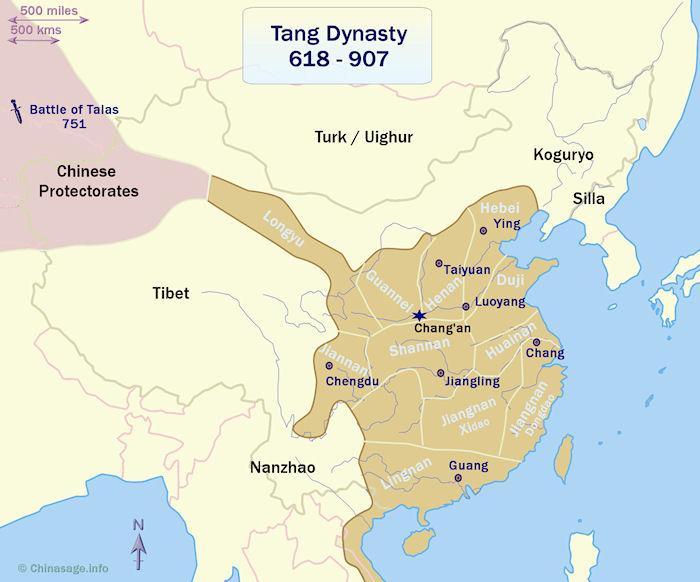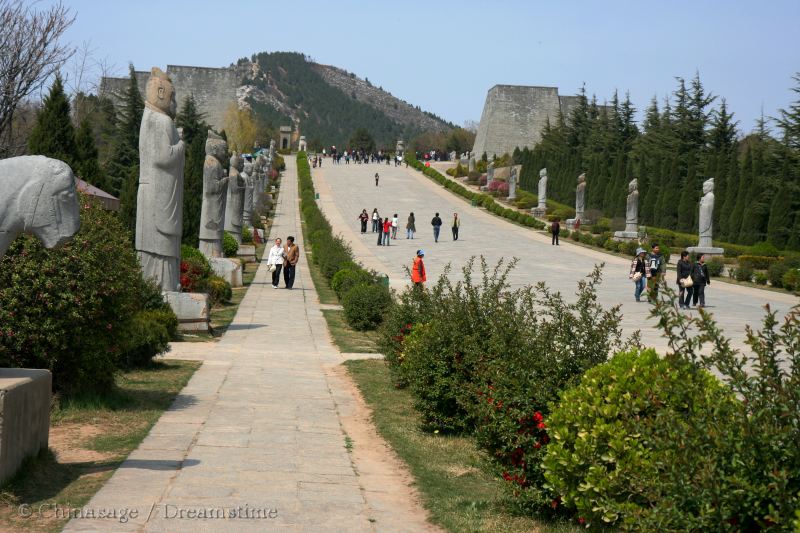Tang Dynasty 唐朝 618 - 907


Echoing the foundation of the preceding Sui dynasty the illustrious Tang dynasty was founded by a northern aristocratic family member serving as an official in the Sui government. Li Yuan [566 - 635] rose in revolt at Taiyuan, Shanxi against Emperor Yangdi in 617 and soon captured the capital, he took the name Gaozu (‘High Ancestor’ see section on names) on accession in 618. (Note that the temple name Gaozu had also been used by a number of Emperors including Liu Bang founder of the Han dynasty). His son Li Shimin was the main military genius behind the conquest. Although of mixed Han/Turkic/Mongol/Xianbei descent the imperial Tang dynasty embraced Chinese culture and married into the former Imperial Sui and Northern Zhou families. Their ancestral Turkic language remained in use among the Imperial family members. Li Shimin's eldest son Li Cheng Qian became obsessed with his Tartar ancestry and wore Turkish clothes, spoke Turkish and adopted a nomadic herder's lifestyle. The Central Asian roots is evident in the surviving artwork showing the Tang love of horses, horse riding and polo playing. Emperor Xuanzong famously trained a troop of 100 dancing horses to perform for him.
Tang Emperors and Empress
Gaozu restored peace between the rival ruling families and laid the foundation for the Tang period of wise rule. His land reforms paved the way to peace and prosperity. Gaozu's son Li Shimin [598 - 649] who had the title Taizong (‘High Ancestor’) is one of the great Chinese Emperors, who started by living frugally, seeking advice from others, working hard and ruling wisely. Examples of Taizong's fine calligraphy have been found at Dunhuang, he was artistic and literate. One story recounts how he broke off from a meal to draw an unusual bird that had landed nearby. He drew on all the native Chinese religions in making his decisions. Taizong had the support of one of the wisest of wives, Empress Zhangsan 長孫皇后 (601-635) who is widely thought of as the best of China's Empresses. She offered sound advice and prevented many of Taizong's more silly tantrums. She lived frugally and devoted herself to her husband and children. Taizong's plans to subjugate the Koreans, failed just as Sui Emperor Yangdi had failed before. The corruption engendered by such total power gradually took its toll in Taizong's later years. After a conflict between two of his sons, it was a younger son Gaozong who took the throne.
Gaozong rule was overshadowed by his powerful wife Wu Zetian. She eventually became an Emperor in her own right for the first and only time in Chinese history. For a full description of her eventful life please see our Wu Zetian page.

Xuanzong (712-756) also known as Ming Huang brilliant emperor was a popular emperor who rebuilt the splendor of Tang culture. He founded the leading scholarly institution in 725 - the Hanlin Academy that lasted for nearly 1,200 years. He is famous for an infatuation with his son's wife the beautiful Yang Guifei ➚. The country prospered, the first permanent bridge over the lower Yellow River, the Pujin Bridge was built and the population of China rose to 53 million.

World Center
China remained the dominant Asian power with its capital at Chang'an, the largest city in the world at the time with 2,000,000 inhabitants and measuring 5 miles [8 kms] across. The city's outer wall was given the same shape as the quadrilateral arrangement of stars in the Big Dipper as this constellation has always been important to Chinese people. The city was carefully planned and laid out, reflecting the strong central control of the Tang state. A tenth of the city's population were foreigners: Tibetans; Sogdians; Turks; Persians; Arabs; Christians; Jews and Syrians, it was a very cosmopolitan era. China saw no threat from foreign 'barbarian' states and welcomed their skills and customs. Some contact with the Byzantine Empire ➚ is also documented by Theophylact Simocatta ➚. Supplying the vast city with food was a logistical problem with very difficult transportation by boat up the Yellow and Wei rivers. The grip on southern China strengthened with the inclusion of Fujian province into the Empire. For the first time the empire was administered as a set of ten provinces rather than much smaller districts. The provinces were Longyu (roughly present day Gansu); Guannei (Shaanxi); Henan (Shanxi); Hebei (roughly present day Hebei); Duji (Shandong); Shannan (Henan; Shaanxi; Hubei); Jiannan (Sichuan); Lingnan (Guangxi; Guangdong; Vietnam) and Jiangnan (a vast area subdivided into east and western parts covering much of Anhui; Fujian; Zhejiang; Guizhou; Hunan; Jiangxi; Jiangsu). Guangzhou developed rapidly as a port on the south coast with good roads to the rest of China. The most prized export shifted from silk to porcelain which is more suited to transport by boat rather than by land.

Tang dynasty Culture
Culturally, the Tang dynasty is seen as another peak in Chinese development. The first printed books in the world were produced. Immense iron chain bridges were built as well as water mills. Control of irrigation became more sophisticated bringing more land into cultivation. Tea was extensively planted and Tang porcelain became highly prized. There was a great literary flowering with many great poets including Li Bai and Du Fu creating timeless classics. The Hanlin Academy (‘the Forest of Pens’) promoted literature. In administration the Tang mainly followed the Sui system although the reformed system still relied on grain levies on poor farmers. Nine grades of nobility were created which received a fixed proportion of the income from taxation. The first class princes (wang) were the top grade made up of sons and brothers of the emperor; the next two grades were more distant relatives; the remaining six grades were for eminent officials. So although most officials came from the leading literati families (士 shì) it was possible for people of merit to be appointed to high posts through the examination system.
Battle of Talas 751CE
During the Tang dynasty, the empire expanded far to the west along the Silk Route the main artery of Tang trade to touch the Aral Sea ➚. It was the rise of the Sogdian people, centered at Samarkand ➚ that greatly expanded the trade as transport became much safer and regulated. Chinese expansionist dreams were brought to a halt at the Battle of Talas ➚ in 751 and at the same time there was an unwise campaign to subjugate Yunnan. It was the growth of Islam that fueled the conflict; Abbasid ➚ troops met a combined force of Chinese and mercenary Karluk troops. During the battle the Karluk troops changed sides and this proved decisive, very few Chinese troops survived. China lost control of the area which is now Xinjiang and Qinghai provinces, at one stage her influence had extended as far as Pakistan. Perhaps most importantly the Arabs captured mercenaries skilled in the manufacture of paper. Paper mills were then built at Samarkand and from there, the secret made its way to Europe and the rest of the world.


Decline and Fall of the Tang
After the tumult of the An Lushan rebellion, Xuanzong's son Suzong eventually restored peace, with aid from foreign mercenaries but only to see a new power, the Tibetans, invade and sack Chang'an. In 766 some stability was established under Dezong (Suzong's son) but the centralized power of the early Tang rulers was never reinstated. The majority of the unrest was in northern China; in the Yangzi valley and further south peace was preserved, this period marked the shift to the south of Chinese culture, areas in the north became depopulated with cities left in ruins while in the south new towns and cities were built. Yangzhou, Jiangsu near the Yangzi river became a large, rich city rivaling Chang'an taking the bulk of the commerce and even had rudimentary street lights (the first in the world to do this).
Next Festival
Tuesday 17th February 2026
Chinese New Year - Spring Festival (Chūnjié 春节)
Read more...
Buddhism was the religion of the Tang emperors; it was a period of carving of huge numbers of Buddhas in such places as Dunhuang, Gansu; the Longmen Caves and the Yungang Grottoes. Towards the end of the dynasty Buddhism had become very powerful and rich, but it was then fiercely persecuted (841-846) by Emperor Wuzong and never again achieved the same dominance. Wuzong's conversion to Daoism probably led to his death by mercury poisoning. Nationalism was resurgent with foreigners: Turks, Jews, Muslims, Christians, Parthians were dispossessed and some murdered. The state turned back to Confucianism as the ruling doctrine, and central control was lost, local fiefdoms emerged particularly in the north.
Natural disasters took their toll too, a series of droughts in Shandong and Henan led to peasant rebellions. The remnants of Tang administration resorted to high levels of taxation and confiscation of land. At one stage a ‘Green shoots tax’ was instigated, so farmers had to pay a tax on crops as they germinated long before harvest. Misrule and dominance by court eunuchs, encroachment of Arab armies from the west led by Uighurs, and rebellions all led to the breakdown of the empire into smaller 'fiefdoms' . Huang Chao (黄巢) ➚'s rebellion proved the main cause of the demise of the illustrious dynasty and the birth of a period of strife: the Five Dynasties and Ten Kingdoms. The greatest city in the world Chang'an was totally destroyed - leveled to the ground in 904.


